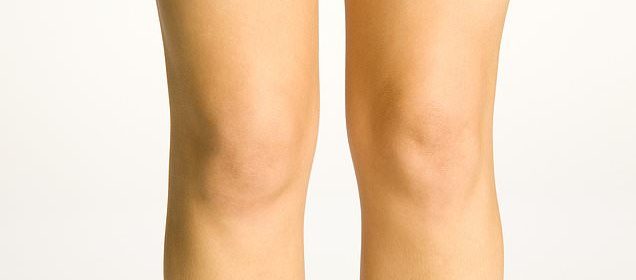One-stop operation to straighten wonky knees

One-stop operation straightens wonky knees – with patients ‘walking straight away’ and ‘back to their normal lives in weeks’
- A ‘one-stop’ operation offers a quick fix for severely bent and curved legs
- New approach means surgeons straighten knees as the patient lies in theatre
- The procedure is known as computer hexapod assisted orthopaedic surgery
Pioneering surgery to straighten wonky knees is sparing patients from months of discomfort strapped to a clunky brace.
The ‘one-stop’ procedure offers a quick fix for severely bent and curved legs, with most people up and about the day after the operation.
Bent or misaligned legs can be genetic, but can also develop because of the way the bone melds back together following a fracture. The bend can be in the thigh bone, known as the femur, or the shin bone, called the tibia.
Any misalignment of the bones and joints can put real pressure on the hips, knees and ankles, and wear them down. This can cause agonising pain and leave patients in need of a new joint.
But if the leg is still out of line, there is a risk that the artificial replacement will also wear out quickly. To avoid this happening, patients must have the leg straightened first.
Pioneering surgery to straighten wonky knees is sparing patients from months of discomfort strapped to a clunky brace (stock image)
For patients with complex deformities this means having a cage-like contraption placed around the leg, attached in place with tiny pins that penetrate the bone. The femur or tibia is then cut – effectively rebreaking it.
Following surgery, the patient must move the cage, which acts a bit like scaffolding, by a millimeter every day, gradually moving the leg until it is straight.
The device has to be worn for a further six to 12 months to ensure the bone has mended.
Now a new approach means that surgeons can straighten complex cases, as the patient lies in theatre. The procedure – known as computer hexapod assisted orthopaedic surgery – uses a special cage, which can be immediately removed. ‘This is a one-stop procedure,’ says Amir Qureshi, consultant knee and limb reconstruction surgeon at University Hospital Southampton. ‘They can walk straight away and within a couple of weeks are back to their normal lives.’
The procedure was first developed by surgeons in Bristol. Mr Qureshi is now trialling a new technique, using a special clamp, which makes the operation less fiddly.
The operation can take several hours and is carried out under general anaesthetic. The surgeon uses CT scans and special computer software to work out exactly where the bone needs to be cut so it can be realigned.
Now a new approach means that surgeons can straighten complex cases, as the patient lies in theatre (stock image)
In theatre, the cage contraption is put around the patient’s leg. This is then attached to a clamp, which is fixed to the outside of the bone using screws. Unlike traditional methods using pins, these do not penetrate the hollow inside of the bone. An incision is then made in the leg and the femur, or tibia, is cut.
Computer software is used by the surgeon to adjust the cage, slowly moving the leg into the straight position.
A rod of titanium alloy is then inserted into the bone to hold it together as it heals. The cage and clamp are removed and the patient’s leg stitched up.
They are usually able to walk a day later and go home within two days. The rod is removed once the leg has properly healed.
Gillian Shorter, 62, from Winchester, is one of those to have undergone the procedure.
In 1984, she smashed the bone below her knee in a motorcycle accident. It was put back together using pins and a plate but was never straight, and a few years ago she began to suffer excruciating pain. ‘It was difficult to walk any distance,’ says Gillian.
She had the new operation in August last year, and was up on crutches within days. She is now able to walk better and tackle stairs, with little discomfort.
‘The idea of having a cage terrified me,’ Gillian says. ‘I really didn’t want to waste two years getting back on my feet.’
Source: Read Full Article

